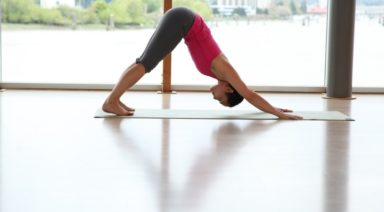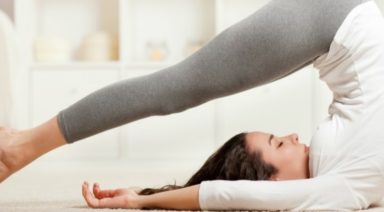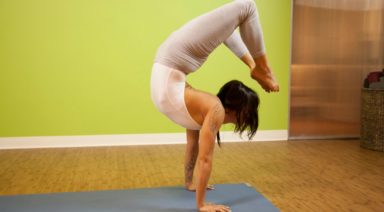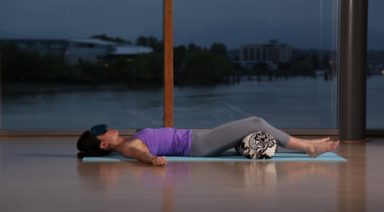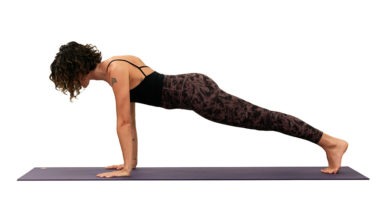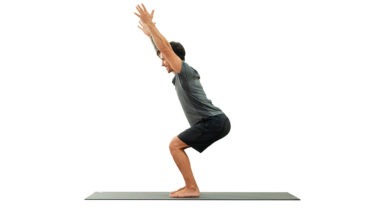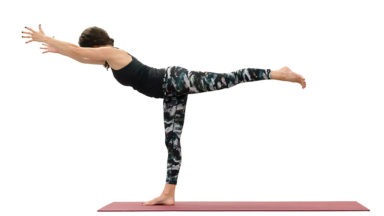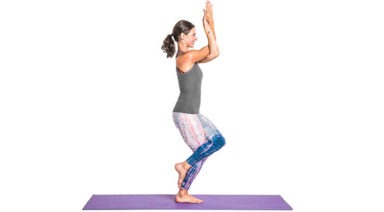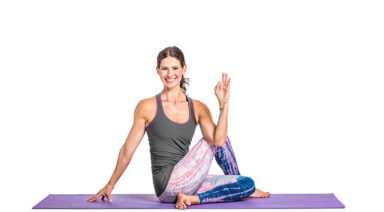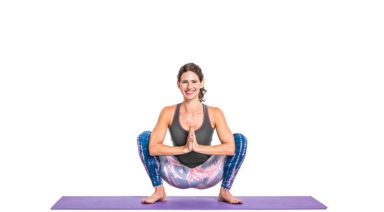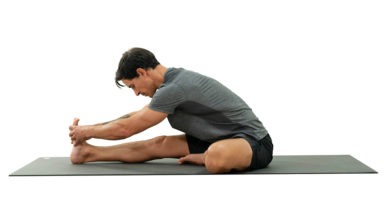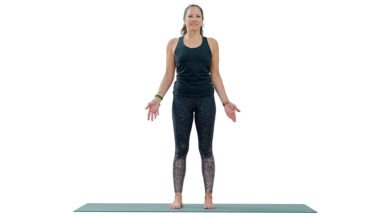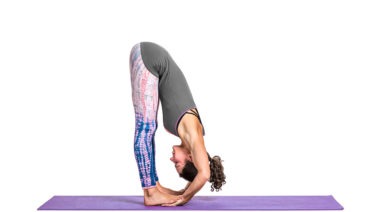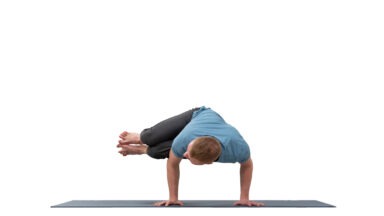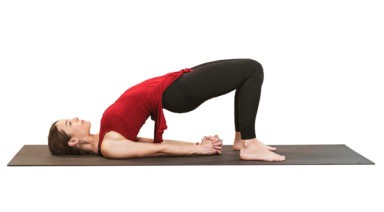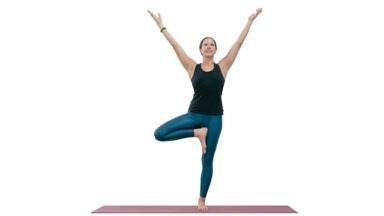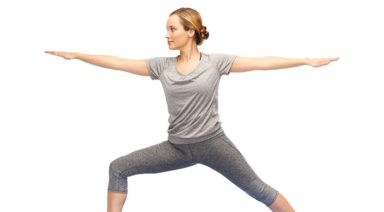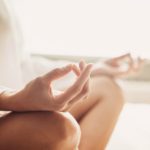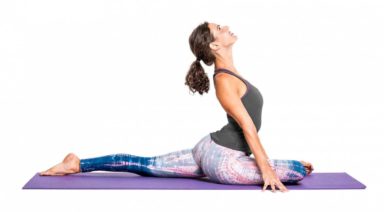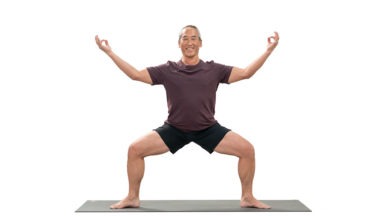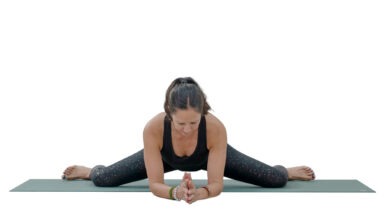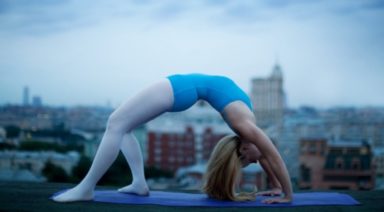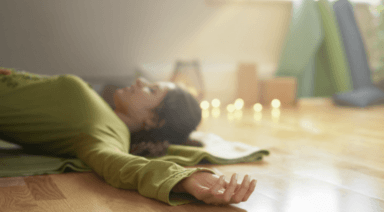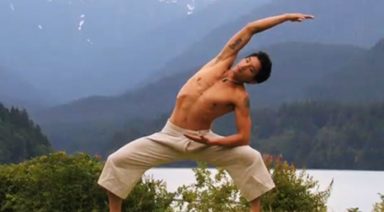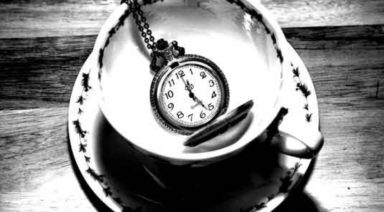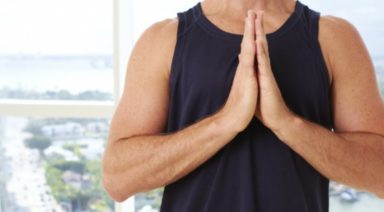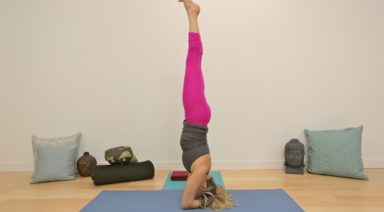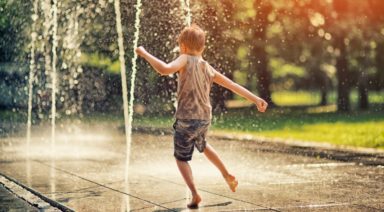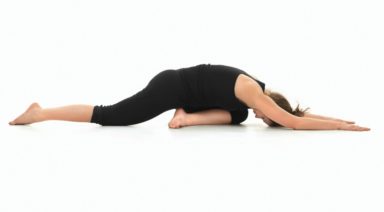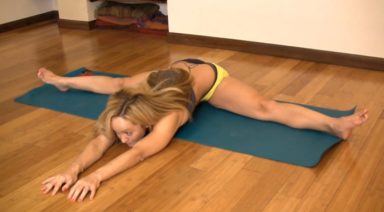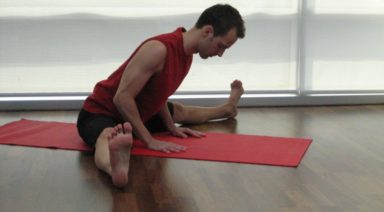Legs-up-the-Wall | Yoga Pose
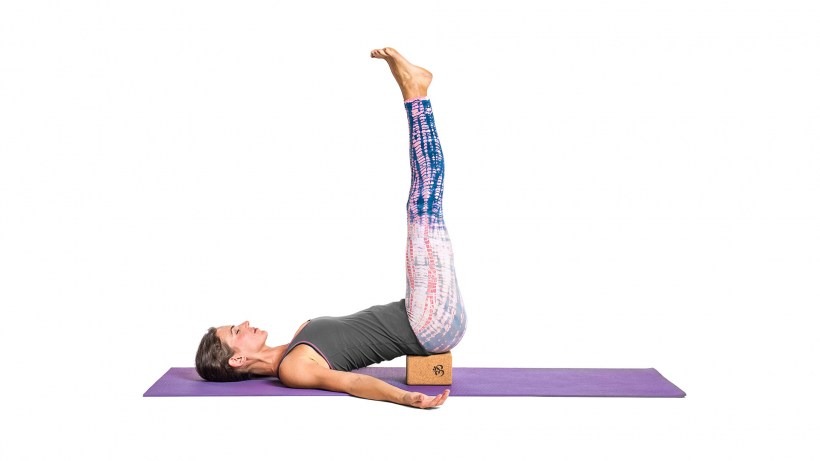
ADJUSTMENTS | BENEFITS | CONTRAINDICATIONS | MANTRA | MUDRA | PREP POSES | SANSKRIT | STEPS | TIPS
Viparita karani (vip-par-EE-tah car-AHN-ee), or legs-up-the-wall pose, is a restorative inversion that can ease the mind and relieve painful symptoms such as tension and cramps. Many people enjoy this pose using props — you may want to have a pillow, bolster, or folded blanket nearby.

ADJUSTMENTS/MODIFICATIONS:
- This pose may be enjoyed using props like a pillow, bolster, or folded blanket under your hips.
- To stretch your inner thighs and groin muscles, let your feet fall out to the sides so your legs make a wide “V” shape.
- If you neck is sore, place a rolled up blanket under your neck or a pillow under your head.
CONTRAINDICATIONS AND CAUTIONS:
Although this is a mild, restorative posture, it is still considered an inversion. While many teachers recommend legs-up-the-wall pose as a therapeutic posture, please check with your doctor if you are experiencing any of the following:
- Menstruation
- Pregnancy
- Glaucoma
- High Blood Pressure
TIPS:
Use a blanket or pillow under your hips to release any tension in the lower back.
Place a blanket on the soles of your feet for a grounded sensation.
No wall? Place a block or blanket under your hips and stretch your legs up to the sky, finding a place where your legs feel almost weightless.
STEP BY STEP:
- Find an open wall space. Start seated beside the wall, with shoulder and hip touching the wall. On an exhale, gently lie down on your back and pivot yourself so that the backs of your legs press against the wall and the bottoms of your feet face upward. You may need to wiggle around to find your way into this position.
- With your sitting bones pressed up against the wall, or slightly away from the wall, rest your back and head on the floor; this will form an approximate 90-degree angle with your body.
- If you find this position uncomfortable in any way, or just wish for extra cushion, you can use your prop here. By pressing the bottoms of your feet into the wall, lift your hips slightly, and slide your prop underneath your hips.
- Let the back of your head feel heavy with your neck in a neutral position. Soften your face and your throat. Let your hands rest face-down on your belly or face-up along the sides of your torso. Close your eyes and breathe deeply through your nose.
- Stay here for anywhere from five to 15 minutes. To come out of the position, push the bottoms of your feet into the wall and lift your hips slightly. Remove your props. Gently roll to one side for a few breaths before returning to your seat.

PREPARATORY POSES:
Viparita Karani is usually a restorative pose, performed near the end of a practice, but it can easily be practiced as a pose by itself. Preparations include:
- Bridge pose | Setu bandha sarvangasana
- Standing forward fold | Uttanasana
FOLLOW-UP POSES:
- Savasana
SANSKRIT:
- Viparita: reversed/inverted
- Karani: doing/action
- Asana: pose
PHYSICAL BENEFITS:
- Offers relief from symptoms of arthritis, headaches, high/low blood pressure, and insomnia.
- Eases symptoms of PMS and menopause.
- Relieves tired, cramped feet and legs.
- Gently stretches the hamstrings, legs and lower back.
- Relieves lower back pain.
ENERGETIC BENEFITS:
- Calms the mind.
- Eases anxiety and stress.
MANTRA:
“RA MA DA SA SA SAY SO HUNG”
A well-known mantra used to stimulate the body’s natural ability to heal itself, this mantra connects us with the healing abilities of the earth and universe at large. Reciting this mantra can help strengthen the immune system while calming the nervous system, easing you into a calm state of healing. It also represents the strengthening and healing of the mind and emotions.
MUDRA: SURYA MUDRA
Surya mudra (gesture of the sun) represents life, rejuvenation, and health. Bend the ring finger to the palm and place the thumb on top of the ring finger.
Benefits:
- Helps the digestive organs and relieves indigestion.
- Holistically boosts metabolism.
- Gives revitalized energy and strength to the nervous system.
- Sharpens the center within the thyroid gland.
- Relieves symptoms of anxiety.
Legal Disclaimer Before participating in any exercise program or using any fitness products or services that may be described and/or made accessible in or through the Gaia Website and/or the Services, you should consult with a physician or other healthcare provider. Read more about Gaia’s Terms Of Use.
The Yoga Pose You're Doing Wrong (and How to Modify it Safely)
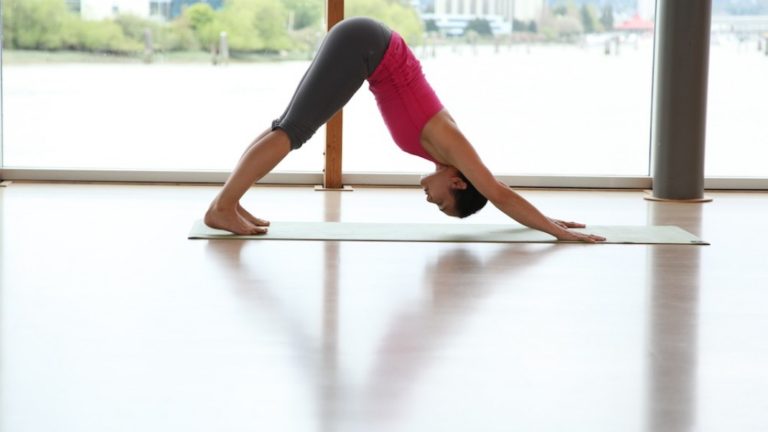
Take any yoga class and it’s almost guaranteed that you’ll do downward facing dog, or adho mukha svanasana, at least once. If you’re a fan of flow classes, the amount of times you’ll find yourself in down dog increases exponentially. For beginners, despite their teacher’s touting down dog as a pose of rest, it feels less like rest and more like a full body workout. This isn’t exactly untrue. When downward facing dog is executed properly the core is engaged and the entire back body is stretching, with the arms bearing some of the body’s weight, making down dog a pose that works the entire body from hands to heels. A correctly executed down dog also has many physical and mental benefits, including building bone density, increasing circulation, developing flexibility, calming the mind and counteracting fatigue. But when done wrong the benefits of the posture may be lost and put the yogi at risk for injury, especially if they’re hitting downward facing dog repeatedly.
Most of the students I see in class doing down dog incorrectly are making the same mistake. They slump forward into their shoulders, hunching their upper back and misplacing the majority of the weight from their trunk and hips into their shoulders and wrists. The shoulder, a ball and socket joint, is a shallow joint with a complex network of muscle and ligament attachments. This gives the joint a lot of flexibility but also increases the risk of injury, especially dislocation or wear and tear injuries involving the rotator cuff. Shoulder injuries can be extremely painful, and in some cases, can become chronic problems. Because of the complexity of the shoulder’s structure and a modern lifestyle that doesn’t always encourage strong muscle development in the area, shoulder injuries can be hard or impossible to repair, even with surgery. This makes properly practicing poses where the shoulder can be vulnerable, such as down dog, extremely important. Yoga is supposed to make us feel good inside and out, not leave us with chronic pain.
So how do you know if you are doing down dog correctly? First and foremost, listen to your body. If you are feeling discomfort or sensations that don’t resemble the description above, chances are something is off. Are the heels of your hands digging uncomfortably into the ground? Do your shoulders feel heavy and seem to sag toward your ears? Is there little to no feeling of stretch happening throughout your back or hamstrings? Does it feel as though your back is curving upward, like it does during cat pose? These may be signals that you need to make adjustments.
In a proper down dog the base of the pointer and pinky fingers and the heel of the hand should be pressed firmly into the mat. The arms should feel engaged, long, and be externally rotating, with the bony part of the elbows tracking backwards toward the body, rather than facing outwards. The shoulders should be pushing back from the ears with the shoulder blades pressing flat to the ribs. The back body should feel long and flat. The hips should continue this line, so that the entire top half of your body creates a long line from the base of the hands to the tailbone. The legs should feel a stretch through the hamstrings, with the knees straight, but not locked, and the heels pressing toward, or onto, the mat. The feeling should be of the thighs pressing back away from the arms. The lower half of the body is ideally a long line from hip to heel. The entire pose should look like two lines forming an inverted “V”.
Aren’t there exceptions to every rule? Isn’t a yoga practice about showing up and working to your level, rather than striving for the perfect posture all the time? Absolutely. But there is a difference between working on a posture where you are at, and working on a posture unsafely, even if you aren’t striving to put your body into a pose it isn’t ready for. As practitioners, part of being accountable for our practice is seeking guidance when something doesn’t feel right for our bodies. This goes beyond listening to descriptions or corrections given out in class. It means remembering that being pro-active can save us from unnecessary injury or chronic pain. If your down dog doesn’t seem quite right, an experienced teacher can provide you with the guidance to modify it to suit your body and practice while allowing you to safely reap the benefits of the pose.









